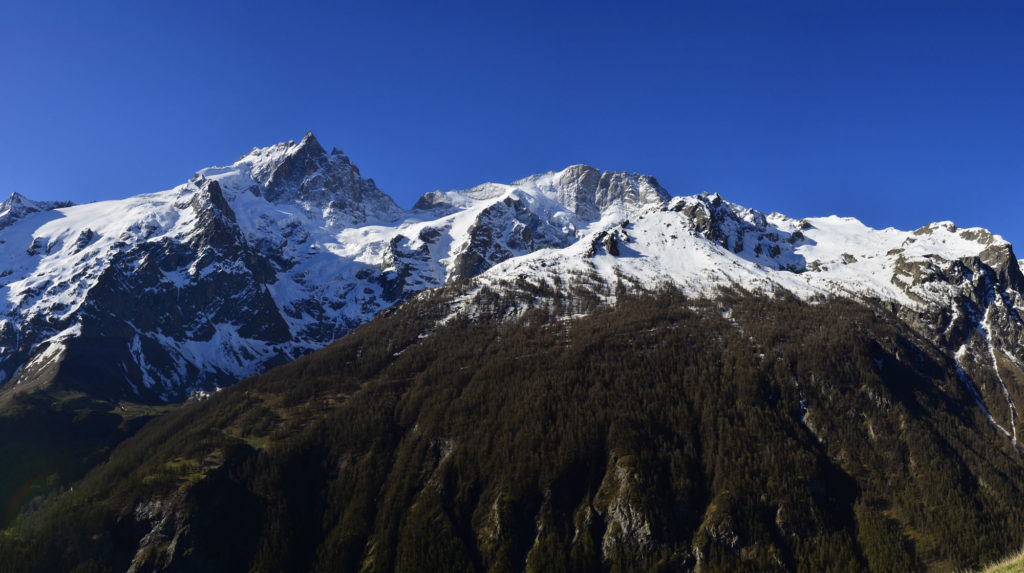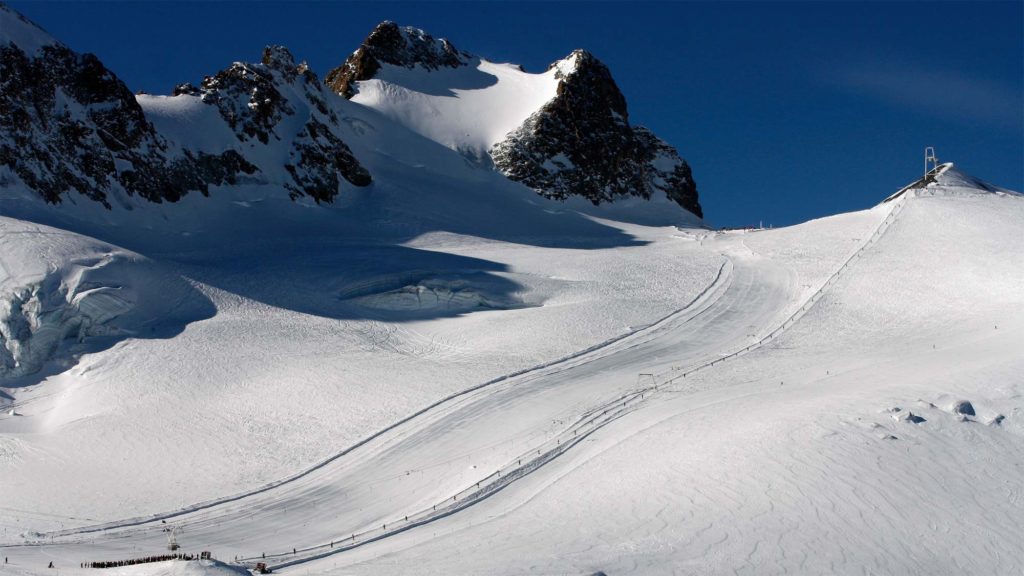« How to project yourself into the future by taking into account the ecosystem, the sustainability of local life, welcoming lovers of the great outdoors, those who are simply curious about the mountains and professionals alike?
How to educate our younger generations, offer scientists a place to work and study?
How to make the mountain universal, while respecting its identity and what it represents for us, but also for its ecosystem?
In response to this, SATA Group took care in 2017 to make the Délégation de Service Public de la Grave a subsidiary in order to preserve the unique and mythical side of this place. The challenge is to work closely with the other players in the area to find the balance needed to ensure the continuity of local life and the preservation of this extraordinary environment.
Making the mountains accessible is at the heart of our business as a mountain resort operator, and we are proud to be able to offer, through our ski lifts, a means of transport that can be used by anyone who wants it. The curious, the passionate, the contemplative, the young and the not-so-young, seasoned sportsmen and sportswomen, or even those who can’t be, people with Reduced Mobility – everyone has the right to access this natural space and to take an interest in it.
The Girose Glacier is part of our National Heritage, and must remain accessible to those who wish to visit it. We support the scientific studies being carried out there, and hope that in such an authentic place, passing on this sensitivity to future generations will bear fruit and serve the interests of preserving the environment on a daily basis, not just in the mountains..
La Grave is a unique site that needs to be preserved, both in terms of its natural fragility as a glacier, but also in terms of its quality as a place to live for hundreds of inhabitants who live off their land, on their land.
SATA Group is at the service of its territory and its inhabitants: independent, completely objective and above all without partisan lobbying.. »
Fabrice BOUTET, President of SATG.
The 20th of Mai 2021
Since 2017, the La Grave site has been operated by SATA via its subsidiary SATG Haute-montagne (Société d’Aménagement Touristique de la Grave). Created in 1959 in Alpe d’Huez at the instigation of local players keen to develop mountain resorts on the Huez mountain pastures, over the years SATA has become a key player in the Alps. Today, the group brings together the Delegations of Public Services for 3 exceptional areas: l’Alpe d’Huez (1959), La Grave (2017) and Les 2 Alpes (2020).
With its strong local roots, SATA Group is supported by the 800 men and women working at its three sites. 100% of our staff work and live in Oisans.
Positioned as a local alternative on a human scale to the large groups that have occupied the market until now, SATA Group is a development tool at the service of the region. By responding to calls for tender issued by local authorities, it contributes its expertise to the human and economic development of the region.
In 2017, the commune of La Grave awarded SATA the Délégation de Services Publiques contract for its cable cars. To respond as closely as possible to the specific needs of this unique domain, and to preserve the strong identity for which La Grave is renowned, a subsidiary (SATG) was created to give the teams the freedom they needed to manage their site.

Since the 19th century, and the rise of mountaineering in the Alps, The site of La Grave has always held a special place in the history of the mountain. In the 1970s, with a view to improving living conditions for its residents and the local economy, the commune embarked on a programme to make the village of La Grave more attractive through mountain tourism. The first section of the cable car was built in 1976, followed a year later by the second, which reaches the Girose glacier at an altitude of 3,200m.
10 years after its creation, in 1986, due to a lack of economic profitability, it was shut down by the supervisory authorities because compliance work was required but could not be carried out.
In 1987, its designer applied for the public service delegation, which required the creation of the Girose and Trifide ski lifts in order to make the lift economically viable for the region. The balance is fine, very fine, on the edge.
More than 40 years later, the gamble has paid off since la Grave has succeeded in combining economic development with the preservation of its unique identity. The “secret spot” in the Alps, which has been attracting mountaineering enthusiasts from all over the world for decades, has managed to retain the identity that has made it unique and legendary the world over.
Since 2014, we have been looking at ways of making the village more attractive in the long term, and thus enable its inhabitants to continue to live off their land, on their land
between April and November 2015, The collapse of the Chambon tunnel cut off the village of La Grave from its Isère gateway. Connections to the Grenoble conurbation, as well as to Lyon and the Rhône basin, are only possible via a long diversions over the Col du Galibier or Lus la Croix Haute. The region’s economy, which is heavily based on tourism, has been shaken by this closure, which has had a severe impact on the 2015 summer season and subsequent seasons until 2017 : shopkeepers have lost almost 50% of their usual turnover in the 2015 season, and families are leaving the area.
Repositioning La Grave as a tourist destination in its own right is therefore a real challenge for the region and its economic survival.
The new Public Service Delegation proposed by the commune of La Grave in 2016 is therefore aimed at maintaining the tourist appeal of the area.
The project is part of a wider vision called ‘Experience La Grave’, which aims to modernise the mountain resort while preserving the special soul that makes La Grave unique.
In 2017, the first section of the cable car was renovated, with a focus on respecting the Vallons site : stations are being brought up to standard and modernised, with cabins replaced by more comfortable and safer versions. However, the throughput remains the same (440 people/hour) in order to keep the number of visitors to the site under control, and the mythical train of cabins in shades of orange continues to illustrate the identity of La Grave. At the same time, we dismantled and cleaned up obsolete installations (chairlifts, cable drums on the glacier dating from the construction of ski lifts, etc.)..
Between spring 2022 and autumn 2023, as part of the plan to modernise the cable car line, SATG carried out the renovation of the second section between 2400m and 3200m, always in the same spirit of modernising without altering. : the cable car has maintained the same flow rate.
This Experience La Grave project also highlights the environment and biodiversity present on the site. An exploration trail has been laid out along the cable car line, in the immediate vicinity of the stations, to give the general public a fun way to learn about high mountain themes, fauna, geology, glaciers and flora.
La Grave station and the village are the starting point for discovering the high mountains, just as they were the starting point for ascents in the early days of mountaineering.
The Peyrou d’Amont station, located at 2400m, offers contemplative experiences to help you admire and understand the environment around you in peace and quiet.
At an altitude of 3200m, visitors reach the Glacier de la Girose via the Col de Ruillans. The modernisation of this arrival station is also an opportunity to offer a unique space for scientific and educational purposes. Aimed at passing on information to the general public and to future generations, this new exhibition and discussion space is part of a drive to raise awareness of the future of our glaciers and the consequences of global warming in the high mountains.
Replacing the existing ski lift on the glacier is also an important step in adapting La Grave’s offer to the new climatic requirements. The current ski lift, which is still powered by an internal combustion engine, is no longer an option, and the work required to prepare its ascent track on the glacier is no longer acceptable.
With its replacement, we aim to reduce greenhouse gas emissions by 75%, as well as cutting the area groomed on the glacier by more than 60%.
Following a number of economic and territorial studies carried out during the Chambon crisis and consultations with the local population, the commune decided to include the replacement of the ski lifts by the construction of a cable car in its public service contract.

Carte d’identité du téléphérique :
The third section of the cable car represents a balance between preserving our glacier thanks to the removal of all the constraints associated with the ski lift, but also economic sustainability by maintaining the current activity, but also by opening up the mountain to other visitors, such as children, people with reduced mobility, etc. Developing the offer at La Grave is an opportunity for the local population to continue to live off their land, on their land, etc.
The construction of this cable car and its stations is planned in line with the commitments made by SATA in the public service contract, and with the values that La Grave has upheld for decades.
We are aware of the fears and doubts expressed by some lovers of the destination, often because of a lack of information about the project. SATA, through its subsidiary SATG, is committed to respecting the site, both in terms of its environment and its identity.
SATA’s historic values are more than ever committed to La Grave, and the desire to be present on this exceptional site is a source of pride and a responsibility commensurate with the commitments made..
The environmental public enquiry was held from 19 December 2022 to 20 January 2023. At the end of the enquiry, the investigating commissioner submitted his FAVORABLE report and its conclusions on 16 February. visit the La Grave townhall website to consult them (in french).